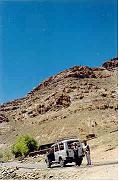'I believe any trip in search of wildlife can be coupled with physical activity and elements of cultural diversity to form a thrilling opportunity ' : John
H.Eickert
 “Julay” is the traditional greeting in the most northern province of India. Ladakh is found between the windswept Tsangpo Plateau and the snow
covered heights of the Middle Himalayas. In this article, I will provide an overview of the Zanskar area of Ladakh. I believe any trip in search of wildlife can be coupled with physical activity and elements of cultural diversity to form a thrilling opportunity.
Ladakh or “Land of White Copper” has two main rivers. The Indus, which flows into India via the Tibetan Plateau and the Zanskar, which joins the Indus below the capital of Leh and has carved the “Grand Canyon of India.” The Zanskar offers one of the worlds
great rafting opportunities. The Zanskar valley holds one of the last surviving areas of the Indo-Tibetan culture and some unique and endangered wildlife.
“Julay” is the traditional greeting in the most northern province of India. Ladakh is found between the windswept Tsangpo Plateau and the snow
covered heights of the Middle Himalayas. In this article, I will provide an overview of the Zanskar area of Ladakh. I believe any trip in search of wildlife can be coupled with physical activity and elements of cultural diversity to form a thrilling opportunity.
Ladakh or “Land of White Copper” has two main rivers. The Indus, which flows into India via the Tibetan Plateau and the Zanskar, which joins the Indus below the capital of Leh and has carved the “Grand Canyon of India.” The Zanskar offers one of the worlds
great rafting opportunities. The Zanskar valley holds one of the last surviving areas of the Indo-Tibetan culture and some unique and endangered wildlife.
To reach Ladakh and the Zanskar one can fly from Delhi, but I recommend going overland. Leh has an elevation of over 11,000 feet and acclimatization can be a problem. Headaches and fatigue are a common complaint following arrival. The overland road eases
this problem and offers spectacular scenery and wildlife viewing. The bumps, grinds, and dust from overland travel are merely an introduction to this high cold desert. While traveling by bus or private car there is always the possibility of viewing brong
dong (wild yak), kyang (wild horse), nyan (bighorn sheep), chim or sometimes chiru (Tibetan antelope and source animal for the mythological “golden fleece”), goa (Tibetan gazelle) and the greater hunter of the high mountains the snow leopard. Some of the
oldest monasteries extant on the Tibetan Plateau are found in Ladakh and are a joy and mystery to tour. An interesting side trip while acclimatizing in Leh is the Khardung La. This motorable pass ascends to 18,385 feet and is proclaimed the highest road
in the world!
Several days’ drive from Leh is the
put in for a rafting descent of the Zanskar. Tongri village is deep in the Zanskar not far from the confluence of the two forks of the river, the Doda and the Tsarnpchu. This is an important barley-growing region and at certain times of the year, it is possible
to view black-necked cranes, Bactrian magpies, Turkoman rock pigeon, (common here) and desert wheateaters. The region is home to 170 species of bird, most uncommon in other parts of India.

From Tongri the river drops through
a deep gorge with walls rising to 3000 feet. Bar-header geese, bearded vulture, golden eagle, marmot, and ibex are common. The river descent should take five or six days. The water is fast and cold and the experience rounds out an amazing adventure. Be
prepared to feel your heart pound! Rafting trips are available from Delhi or Leh, 14 days should be considered a minimum from Delhi and eight days from Leh. July through September is the best time. Trips of shorter duration are available with considerable
compromise to safety. Take the time and take your time! Enjoy.
( Photograph of road to Leh by
Thomas Chacko)
Contributed by
John H.Eickert
Num Bum Adventures
or call 406-777-2228.